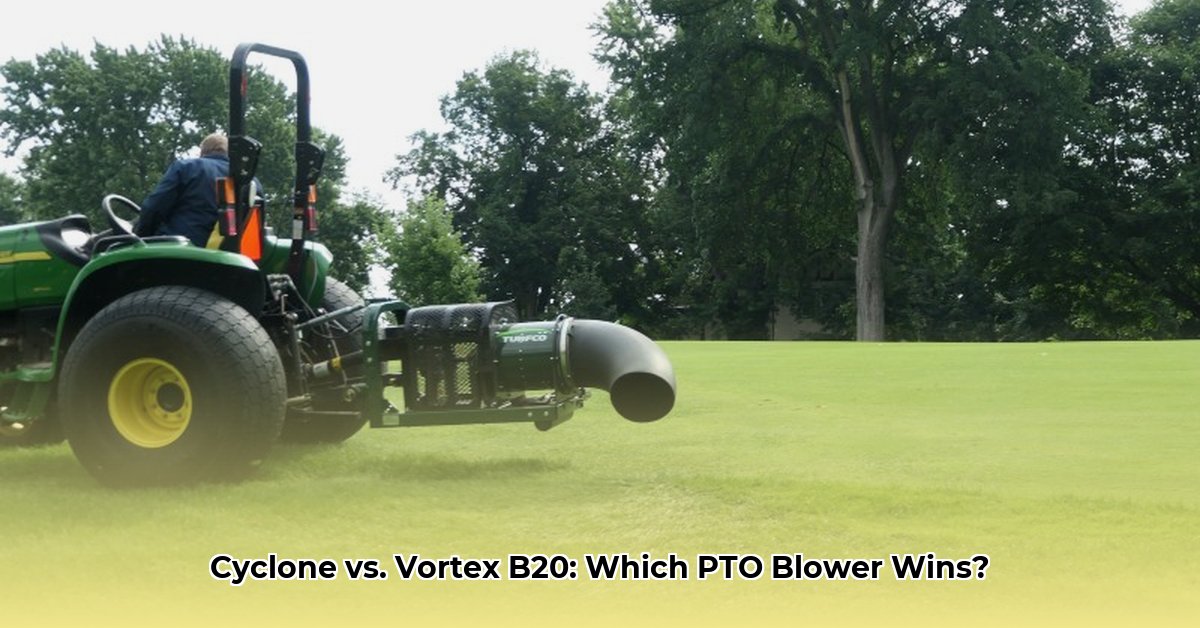
Choosing the right PTO-driven debris blower can significantly impact efficiency and cost-effectiveness on your farm or landscaping operation. This comparative review analyzes two leading models: the Buffalo Turbine Cyclone and the Votex B20, highlighting their strengths and weaknesses to help you make an informed decision. For more PTO tractor information, see this helpful resource.
Buffalo Turbine Cyclone Review
The Buffalo Turbine Cyclone is renowned for its robust construction and powerful performance, making it ideal for large-scale debris clearing. Its direct-drive gearbox and durable design promise reduced downtime and easier maintenance. However, its substantial weight (240 lbs) may limit maneuverability in confined spaces.
Power and Performance
The Cyclone boasts significant power, making quick work of vast areas. However, reports suggest the manufacturer's recommended horsepower (20-25 hp) may be optimistic for some applications. More powerful tractors might be necessary depending on the terrain and debris volume. Crucially, data on cubic feet per minute (CFM) and airspeed are currently unavailable, hindering a precise performance comparison. Further research is needed to fully assess the Cyclone's output.
Design and Build
The Cyclone's simple, robust design is a major advantage. Fewer moving parts contribute to easier maintenance and reduced repair costs. Its heavy-duty construction suggests a long lifespan, backed by a manufacturer-claimed 10-year warranty.
Maintenance and Cost
The straightforward design simplifies maintenance procedures, potentially saving time and money. However, the high initial cost of the Cyclone is currently unavailable publicly and needs further investigation.
Summary of Pros and Cons
Pros: Powerful performance, durable construction, simplified maintenance. Cons: Limited maneuverability due to weight (240 lbs), unavailable CFM and airspeed data, high (unspecified) cost.
Votex B20 Review
The Votex B20 prioritizes maneuverability and versatility. At approximately 216 lbs, it’s significantly lighter than the Cyclone, allowing for easier operation in tighter spaces and varied terrain. Its design incorporates various attachments such as a rotatable funnel and extension hose, increasing its adaptability for multiple tasks.
Power and Performance
While the B20’s power output is stated as 20 hp, specific data regarding CFM and airspeed are missing, preventing a direct power comparison with the Cyclone. This information gap needs to be addressed by either the manufacturers or independent testing.
Design and Build
The B20's lightweight design enhances maneuverability. Additional attachments expand its capabilities, making it suitable for a wider array of applications. However, the increased number of components may slightly complicate maintenance.
Maintenance and Cost
The presence of more moving parts and attachments might increase maintenance complexity and potentially the frequency of service. The initial cost is currently unavailable. The extent to which this added complexity offsets the benefits of versatility requires further scrutiny.
Summary of Pros and Cons
Pros: Lightweight and maneuverable, versatile due to attachments. Cons: Potentially lower power than Cyclone (unverified), unavailable CFM and airspeed data, possibly more complex maintenance.
Head-to-Head Comparison
The following table summarizes the key features of both blowers. Note that crucial performance data (CFM, airspeed, and price) remain unavailable for both models.
| Feature | Buffalo Turbine Cyclone | Votex B20 |
|---|---|---|
| Weight | 240 lbs | ≈ 216 lbs |
| Approximate Power | 20-25 hp (manufacturer claim) | 20 hp |
| Maneuverability | Lower | Higher |
| Versatility | Lower | Higher |
| Maintenance | Simpler | More Complex |
| Price | Unavailable | Unavailable |
| CFM | Unavailable | Unavailable |
| Airspeed | Unavailable | Unavailable |
Conclusion and Recommendations
Selecting the ideal PTO blower depends heavily on your specific needs. The Buffalo Turbine Cyclone excels in raw power and simplicity for large-scale operations. The Votex B20 prioritizes maneuverability and adaptability, making it suitable for smaller areas and diverse tasks. However, the lack of readily available performance data (CFM, airspeed) significantly limits a definitive comparison. We strongly recommend contacting both manufacturers to obtain complete specifications, including pricing information, before making a purchase.
This review highlights the crucial need for more transparent performance data from manufacturers to enable more informed purchasing decisions. Independent testing would greatly benefit potential buyers. Remember to prioritize safety and always adhere to the manufacturer's instructions when operating PTO-driven equipment.